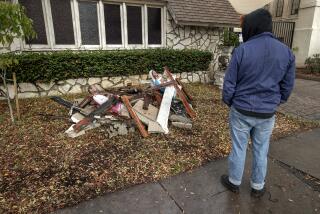The Many Shapes of Nativity
- Share via
The characters in the Nativity scene, including Mary, Joseph and baby Jesus, are crafted from white bread dough that was rolled between the palms of a small boy and colored by youthful strokes with a marker.
Next to it is another Nativity tableau, sculpted by a famous New Mexico artist working with buffalo dung, an unusual medium but one that is common to traditional Native American art. Fired dark and smooth, it has an appraised value of $30,000.
Worlds apart in value and workmanship, the two scenes illustrate the diversity found in the nearly 400 Nativity scenes on public display this weekend in one of the largest such exhibits in the nation.
“They are all so unique, so different from anything you’ve ever seen,” said Vicki Cowell, an organizer of the event being hosted by the Church of Jesus Christ of Latter-day Saints in Orange. “People come here and can’t believe it. It isn’t just a bunch of dolls.”
The free event, which drew about 5,000 people last year, signals the beginning of a season in which Christians celebrate the birth of Jesus and display Nativity scenes that depict the newborn in a manger, Cowell said.
The displays belong to residents throughout Orange County who lend their creches--French for “‘nativity”--each year. The creches originate from more than 30 countries, and are showcased atop garland-draped tables that help convert the church’s bare gymnasium into an elaborately decorated museum, complete with twinkling lights and religious painting.
The works of art are born from a host of materials, from the rarest of woods and stones to gum boxes and tin cans.
One, carved years ago by a church member, is made from three bars of Ivory soap. Another is shaped out of tiny bits of colored clay and delicately perched on the head of a pin.
The scenes also represent a variety of cultures: There is an Eskimo Mary, flanked by a polar bear and made from wool, who is carrying baby Jesus in a papoose on her back; a scene from Guam is crafted entirely from seashells; and a large creche from France depicts a character from every village bringing gifts to the Christ child.
Another display, found tucked away in an attic after its owner died, is billed as the exhibit’s oldest. Crafted in Italy more than two centuries ago, the artist gave Mary and Joseph moving joints, painted-china eyes and lashes from human cadavers.
“It’s quite a thing to see,” said church spokesman Earl Garr. “The clothes are made out of real silk, and their features are just stunning.”
But there are just as many collections that were created not by artists but families and children, “regular folks” who have made unpacking their Nativity scenes each Christmas a household tradition, organizers said. Some of the pieces have been handed down through generations; others are brand new. Church member Kay Powell said organizers continue to add scenes to the exhibit every year as the event becomes more popular.
The church is at 674 S. Yorba Street. Display hours are 3 to 9 p.m. Saturday and 5 to 9 p.m. Sunday and Monday.
“There is such an assortment of personalities and cultures and interpretations of one of the most famous religious scenes in the world,” Powell said. “I mean, we have it all here. And I just love the one made from little marbles. It isn’t worth much, but it sure is cute.”






